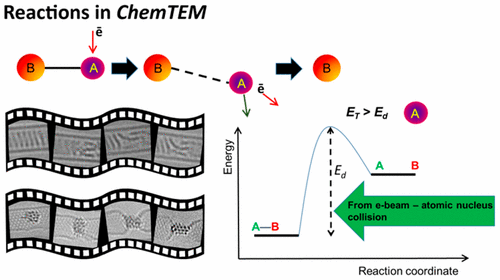当前位置:
X-MOL 学术
›
Acc. Chem. Res.
›
论文详情
Our official English website, www.x-mol.net, welcomes your feedback! (Note: you will need to create a separate account there.)
Chemical Reactions of Molecules Promoted and Simultaneously Imaged by the Electron Beam in Transmission Electron Microscopy
Accounts of Chemical Research ( IF 18.3 ) Pub Date : 2017-07-11 00:00:00 , DOI: 10.1021/acs.accounts.7b00078 Stephen T. Skowron 1 , Thomas W. Chamberlain 1, 2 , Johannes Biskupek 3 , Ute Kaiser 3 , Elena Besley 1 , Andrei N. Khlobystov 1, 4
Accounts of Chemical Research ( IF 18.3 ) Pub Date : 2017-07-11 00:00:00 , DOI: 10.1021/acs.accounts.7b00078 Stephen T. Skowron 1 , Thomas W. Chamberlain 1, 2 , Johannes Biskupek 3 , Ute Kaiser 3 , Elena Besley 1 , Andrei N. Khlobystov 1, 4
Affiliation

|
The main objective of this Account is to assess the challenges of transmission electron microscopy (TEM) of molecules, based on over 15 years of our work in this field, and to outline the opportunities in studying chemical reactions under the electron beam (e-beam). During TEM imaging of an individual molecule adsorbed on an atomically thin substrate, such as graphene or a carbon nanotube, the e-beam transfers kinetic energy to atoms of the molecule, displacing them from equilibrium positions. Impact of the e-beam triggers bond dissociation and various chemical reactions which can be imaged concurrently with their activation by the e-beam and can be presented as stop-frame movies. This experimental approach, which we term ChemTEM, harnesses energy transferred from the e-beam to the molecule via direct interactions with the atomic nuclei, enabling accurate predictions of bond dissociation events and control of the type and rate of chemical reactions. Elemental composition and structure of the reactant molecules as well as the operating conditions of TEM (particularly the energy of the e-beam) determine the product formed in ChemTEM processes, while the e-beam dose rate controls the reaction rate. Because the e-beam of TEM acts simultaneously as a source of energy for the reaction and as an imaging tool monitoring the same reaction, ChemTEM reveals atomic-level chemical information, such as pathways of reactions imaged for individual molecules, step-by-step and in real time; structures of illusive reaction intermediates; and direct comparison of catalytic activity of different transition metals filmed with atomic resolution. Chemical transformations in ChemTEM often lead to previously unforeseen products, demonstrating the potential of this method to become not only an analytical tool for studying reactions, but also a powerful instrument for discovery of materials that can be synthesized on preparative scale.
中文翻译:

透射电子显微镜中电子束促进并同时成像的分子的化学反应
此帐户的主要目的是基于我们在该领域超过15年的工作来评估分子的透射电子显微镜(TEM)所面临的挑战,并概述研究电子束(电子束)下化学反应的机会)。在对吸附在原子薄基质(例如石墨烯或碳纳米管)上的单个分子进行TEM成像期间,电子束将动能转移到分子的原子上,使它们从平衡位置转移。电子束的撞击会触发键解离和各种化学反应,这些化学反应可以与电子束激活同时成像,并可以定格电影形式呈现。我们将这种实验方法称为ChemTEM通过利用与原子核的直接相互作用,从电子束转移到分子的能量,可以准确预测键解离事件并控制化学反应的类型和速率。反应物分子的元素组成和结构以及TEM的操作条件(特别是电子束的能量)决定了ChemTEM过程中形成的产物,而电子束剂量率控制着反应速率。由于TEM电子束同时充当反应的能源和监视同一反应的成像工具,因此ChemTEM揭示原子级化学信息,例如逐步且实时地为单个分子成像的反应路径;幻觉的反应中间体的结构;并直接比较了以原子分辨率成膜的不同过渡金属的催化活性。ChemTEM中的化学转化通常会导致以前无法预料的产品,证明该方法不仅有可能成为研究反应的分析工具,而且还成为发现可以制备规模合成的材料的有力工具。
更新日期:2017-07-11
中文翻译:

透射电子显微镜中电子束促进并同时成像的分子的化学反应
此帐户的主要目的是基于我们在该领域超过15年的工作来评估分子的透射电子显微镜(TEM)所面临的挑战,并概述研究电子束(电子束)下化学反应的机会)。在对吸附在原子薄基质(例如石墨烯或碳纳米管)上的单个分子进行TEM成像期间,电子束将动能转移到分子的原子上,使它们从平衡位置转移。电子束的撞击会触发键解离和各种化学反应,这些化学反应可以与电子束激活同时成像,并可以定格电影形式呈现。我们将这种实验方法称为ChemTEM通过利用与原子核的直接相互作用,从电子束转移到分子的能量,可以准确预测键解离事件并控制化学反应的类型和速率。反应物分子的元素组成和结构以及TEM的操作条件(特别是电子束的能量)决定了ChemTEM过程中形成的产物,而电子束剂量率控制着反应速率。由于TEM电子束同时充当反应的能源和监视同一反应的成像工具,因此ChemTEM揭示原子级化学信息,例如逐步且实时地为单个分子成像的反应路径;幻觉的反应中间体的结构;并直接比较了以原子分辨率成膜的不同过渡金属的催化活性。ChemTEM中的化学转化通常会导致以前无法预料的产品,证明该方法不仅有可能成为研究反应的分析工具,而且还成为发现可以制备规模合成的材料的有力工具。



























 京公网安备 11010802027423号
京公网安备 11010802027423号